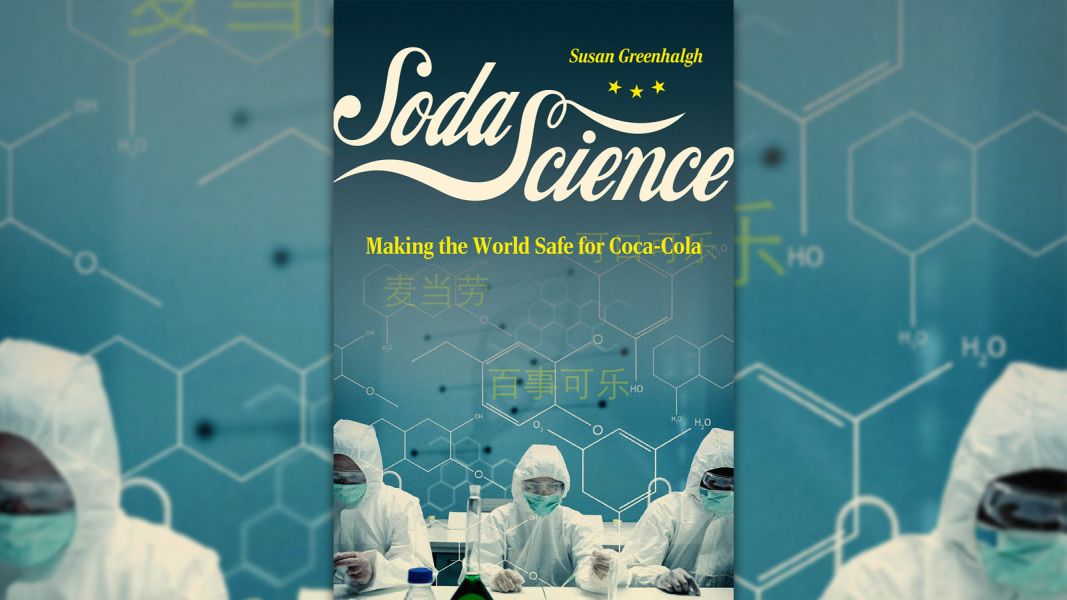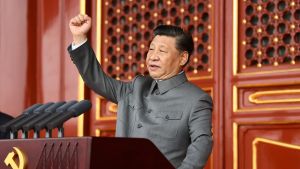
Soda Science: A Conversation with Susan Greenhalgh
To many, a can of Coke is a refreshing treat or an unhealthy indulgence. For years, companies like Coca-Cola have shaped not just our diet and waistlines, but also science and society. Their influence is not limited to the United States. Alongside their products, Big Soda has exported their ideas of fitness and nutritional science abroad, including to China. How has Coca-Cola managed this, and what does this process say about the relationships between science, society, and the state under different political systems? These are some of the questions explored in the new book Soda Science: Making the World Safe for Coca-Cola (University of Chicago Press, 2024). In this conversation, we discuss the book with its author, Susan Greenhalgh.
Yangyang Cheng: Congratulations on the new book! Its title, ‘Soda Science’, is, I understand, short for ‘soda-defence science’, as in scientific research, findings, publicity, and policy in defence of carbonated sugary drinks and related products, incentivised by the very companies that manufacture these products—most notably, Coca-Cola. Instead of calling this kind of research propaganda or ‘pseudoscience’, you emphasise that it is important to take such corporate science seriously and to understand it rather than dismissing it outright. Can you explain why?
Susan Greenhalgh: Let me start with a brief overview of the project. This book is driven by a concern about the hidden corporate corruption of science and the damage it can wreak on unwary societies like China’s. In the story I tell, in the 1990s, once obesity rose to epidemic levels in the United States and public health experts began to finger sugary soda drinks as a main culprit, Big Food mobilised a handful of academic scientists to create what I call soda-defence science, aimed not at finding the best solution to a public health problem, but at protecting the profits of the soda industry and the junk food industry more generally. The soda scientists contended that the main solution to obesity was exercise, not dietary restraint, and that soda taxes were not necessary. Few experts agreed with those views.
The first half of the book traces the creation and sudden demise of soda science in the United States during the years 1995 to 2015. The second half follows the American soda scientists to China, where they persuaded their Chinese counterparts to adopt their view of the best obesity science and worked with Chinese scientists to get it built into China’s policies on obesity and chronic disease.
The US soda industry’s secret weapon was an industry-funded scientific non-profit called International Life Sciences Institute (ILSI). Based in Washington, DC, but with branches around the world, ILSI had sophisticated mechanisms for sponsoring industry-friendly science and exporting it to major markets around the world. ILSI’s China branch was run by a very capable former high-level official from the Ministry of Health. Because of her political position and policy clout, ILSI-China was physically located in the Ministry and became the centre of obesity work in the country during the key years of 1999 to 2015. This extraordinary setup gave Big Food a direct hand in the making of China’s science and policy on obesity.
The book’s aims are both analytical, developing conceptual tools to understand corporate science, and political, holding those responsible to account. To make it accessible to the non-specialist readers, I wrote it as a human story, a narrative tracing the birth, development, death, and afterlife of soda science in the United States and China. Woven throughout its pages, though, are larger themes of potential interest to readers of the Made in China Journal: the entanglement of science and the state, the distinctive features of Chinese science, and the extraordinary power of the word ‘science’ in China.
Going back to your question, you raise a very important point. In America, so many cases of corrupted science have come to light that additional instances tend to produce a kind of collective disgust at the proclivity of large companies to put corporate interests ahead of the public good. The standard response is to simply dismiss the science as junk science or non-science, unworthy of attention.
But corporate science (that is, science funded by companies and created to serve their needs) is more science-like than these observers have acknowledged. Soda science, for example, had all the basic elements of ‘ordinary’ science: it had data, hypotheses, theories, and the like; it was made by prominent scientists; and it was published in well-known scientific journals. Moreover, the claim that corporate science is science gave its makers tremendous power. Its ‘science-ness’ helped protect soda science from exposure by deterring colleagues from looking too closely at how it was funded and made. Only by taking corporate science seriously as science can we understand how soda science became so powerful and went undetected for so long.
Treating corporate science seriously as science allows us to use the tools of science studies to tease out the differences between corporate and academic science and thus answer the big questions about industry-funded science. What drives university-based corporate scientists to do what they do (hint: it’s more than money)? Who takes the initiative (it’s usually the scientists, not the company)? Why do projects of corporate science matter (they shape not only national policies but also people’s ideas, practices, and health)?
YC: It is interesting to read this book about American corporate influence on science in both the United States and China (and likely elsewhere) at this moment, when the US Government has been placing extra scrutiny on perceived Chinese state influence on American science. You elucidate how prevalent yet insidious commercial pressure on academic research can be, and how formal ethical rules often become a formality that protects the institution rather than public interests. Both the American and the Chinese scientists portrayed in your book faced the same source of corporate corruption: Coca-Cola and Big Soda. They held similar beliefs about scientific objectivity but navigated different ethical norms and political landscapes. What are the most important similarities and divergences in the scientists’ approaches to their work between the two countries?
SG: I was excited about studying the transnational circulation of science because it gave me a rare opportunity to compare the workings of the same body of ideas in the two very different political-economic and sociocultural environments of China and the United States. You mentioned some of the main similarities. Another is that researchers in both countries believed in the global hierarchy of scientific value, in which the science of Euro-American countries is unquestionably superior to that of latecomer nations like China. Scientists from both societies saw soda science not as ‘corporate science’ but as ‘American science’, and that perception justified its enthusiastic endorsement by Chinese researchers. Chinese experts thought they were getting the best international science, when in fact what they were getting was merely the best-funded and best-promoted science.
The differences were pronounced. One of the most important was that in the United States, the soda scientists worked for themselves, while in China, they ultimately worked for the state. Whether based in the China Centre for Disease Control or a university, most researchers worked in state-run organisations on projects assigned and funded by the state. This made a huge difference given the Chinese State’s massive political and financial investment in ‘keji’ (科技, science and technology).
Another difference concerns the social structure of science communities. In science generally, research communities tend to reflect the culture of which they are a part. Chinese social and political life tends to be hierarchically structured; the same is true of life in scientific communities. The community of obesity researchers was headed by a powerful former high official from the Ministry of Health. She was the lingdao (领导, boss); she called the shots, she assigned tasks, and she had the right to keep any and all information—including the details of corporate funding—confidential. By controlling that vital information, she was able to quietly facilitate Coca-Cola’s goals while keeping to herself the larger truths about the organisation she led.
YC: Throughout history and in different parts of the world, people have held varying views about the ideal body type. You note that in the United States and especially in this century, being fat is viewed not just as an issue of aesthetics or personal health, but as a moral and civic failing, where the oversized body is weighing down the nation’s progress. The Chinese public, at least until very recently, do not necessarily share the same concerns about obesity, but there is a long tradition of strengthening the individual body to also build a strong national body, part of which you have covered brilliantly in your earlier book, Just One Child (University of California Press, 2008). While body size is elevated to national significance, both the Chinese and the US governments have taken a market-oriented approach to addressing obesity, making it primarily an issue of individual responsibility. Why is this the case, and are there notable differences in neoliberal governance between the two countries in terms of regulating diet and nutrition?
SG: Why the market orientation? The short answer is that it’s easy (cost-saving, face-saving) for both governments to displace on to individuals both the blame for rising levels of chronic disease and the responsibility for combating it. The state’s job is to educate individuals to make the best choices. Market solutions are also a product of the dominant neoliberal thinking of the time (in this case, the 1990s to the 2010s), deemed the correct and virtually only way to go in both countries.
The question of US–Chinese differences in the governance of diet and nutrition is a bit too big to tackle. A systematic comparison of the role of companies in the governance of diet would likely turn up more similarities than we might imagine exist. It’s important to realise there has been a big change under President Xi Jinping. For decades, the Chinese State has pursued economic growth at any cost. It was that economy-first approach that led to the shockingly rapid rise in the chronic diseases of modern life: cardiovascular disease, hypertension, obesity, diabetes, and all the rest. But, in 2016, President Xi recognised that a good worker was a healthy worker and began taking health more seriously (WHO n.d.; Xinhua 2016). He urged health be placed at the centre of every policy and instructed the government to begin creating a systematic body of measures to guide diets and lifestyle practices going forward. The new policies continue to call for market solutions and individual responsibility, but the role of the state in managing chronic disease is growing.
YC: In the United States, perceptions of obesity are also racialised, and thinness is associated with whiteness. This prejudice partly reflects and is further reinforced by a racialised geography of wealth and food access: it takes money, space, and leisure to work out, while pricing and food deserts in Black and brown neighbourhoods mean poor people of colour are often forced to subsist on cheap, empty calories. I’m curious about whether this racial dynamic also helped Coca-Cola’s narrative in shifting the focus from diet to exercise, or whether you have noticed racialised messaging in soda-defence science as well.
SG: This is a great question that I address only briefly in the book. Racial logics do indeed inform soda science, but in ways that have been carefully hidden. In the United States, the ideal of the thin, fit body has been achievable primarily by educated, white, upper-income people, who have the means to reach it—‘the money, space, and leisure to work out’, as you say. In pushing the exercise-first solution, the soda scientists advanced the idea that anyone with sufficient willpower could lose weight and keep it off by simply following their lifestyle prescriptions. Their Step Diet Book, which gave central place to the results of a multi-year study of primarily white, middle-class women, told readers that if these folks can do it, ‘so can you’ (Hill et al. 2004: 30). This apparently race-free assurance, though, was a false promise that worked to blame those least able to reach the ideal: racial and class minorities.
For its part, Coca-Cola has long targeted young ethnic minorities in the United States and youth of colour around the world as its main market. By attracting youthful drinkers, the hope has been to create a market of Coke lovers for life. Photos of young Black Americans or young people of many ethnic backgrounds in the Global South playing basketball or football before breaking to enjoy a Coke send the message that the company’s sugary water brings good health and vigour. These associations all work invisibly, until you start thinking about the world as the racialised place it is.
YC: Chinese society has its own racialised notions of the body and health, some of which have been useful to the Chinese State, as seen in the institutionalisation of traditional Chinese medicine. The Chinese public also raises significant and vocal opposition to certain Western food technologies, such as genetically modified organisms. Many Chinese people—including my mother—insist that a Chinese body is radically different from a Caucasian body. The ‘success’ of soda science in China, in service of Coca-Cola’s corporate interests, seems even more remarkable in this regard. You describe a confluence of factors, from the privileging of Western science and trust in technical authority in the reform era to the Chinese State’s relative neglect of nutritional science, as well as the personal connections and political acumen of individual Chinese scientists. Is soda science unique in terms of Western corporate science in China? Are there other examples or more general lessons, and did soda science face significant pushback in China at any point?
SG: Obesity science supports your mother’s view that the Chinese body is different from the bodies of ‘the standard Euro-American’. Chinese bodies (or, more accurately, East Asian bodies) tend to have more central (belly) fat, upper body fat, and visceral abdominal fat than Caucasians. Excess fat in these locations is more closely linked to diet-related chronic diseases. East Asians develop the chronic diseases associated with obesity—diabetes, osteoarthritis, heart disease, some cancers—at lower body mass index (BMI) levels than do other bodies. For that reason, China adopted BMI cut points that were lower than the global standard. The World Health Organization uses 25 and 30 to mark the lower levels of overweight and obesity; in China the cut points are 24 and 28. Obesity is less visible in Chinese settings than in many places, so people are less concerned about it as a health issue, when they should perhaps be more concerned.
Soda science is highly unlikely to be the only case of corporate science in China. The state’s welcoming attitude to foreign funding of Chinese science, combined with a climate tolerant of fairly high levels of scientific misconduct, has created an environment in which corporate attempts to skew science could flourish. Yet, because of the secrecy surrounding these things, we have no idea how pervasive the corporate funding and distortion of science really is. My suspicion is it’s much more common than anyone realises.
Until 2015, few people had any idea that Coca-Cola was aggressively, if quietly, pushing exercise. So, Chinese researchers would not have been aware of any of this. To the contrary, they thought they were following international best practice in prioritising physical activity for obesity. My research suggests that, although the leaders of ILSI-China were aware that corporate funding of ILSI gave industry leaders ultimate power in the organisation, they may not have realised that the food industry had skewed the science of obesity they had imported and endorsed. Even now, in China, there is little to no awareness of Coca-Cola’s role in perverting science and shaping policy in the country. The response I often hear from Chinese scientists is that the lead figure in the Coca-Cola saga (who is now deceased) was very well respected in China, the implication being that I should not tarnish her legacy, even if my data suggest some of her activities were problematic.
YC: Thanks so much for taking the time to share your thoughts with us! Is there something you would like to add before we wrap up this conversation?
SG: Just one more thing. As we all know, the Party-State is militant about controlling policy in China. My discovery—that soda science penetrated China’s policymaking apparatus to shape health policy—should be a scandal. What will happen when the findings of this book reach China’s leaders? Will they be incensed that a foreign company managed to leave its imprint on Chinese policy? Or will the state’s ties to the Coca-Cola Company—seen, for example, in the joint bottling venture between the state-owned enterprise COFCO (中粮) and Coca-Cola—keep the issue under wraps? I look forward to seeing how this plays out!
References





